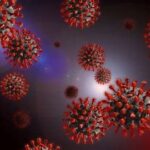So, what does a COVID-19 containment strategy look like without the activist governor’s usual go-to tools of mask and vaccination mandates? Governor Glenn Youngkin has provided the answer with the COVID Action Plan he unveiled this morning.
The key elements are: (1) encourage (but don’t compel) people to get vaccinated, (2) help healthcare providers cope with the surge of hospitalizations caused by the Omicron variant, and (3) re-prioritize testing to identify the virus in K-12 students, healthcare professionals, and medically vulnerable individuals.
“Today’s announcements are designed to give Virginians the tools and resources needed to make the best decisions for their families, strengthen our hospital systems, and ensure a strong recovery as we encounter new challenges associated with the pandemic that has become part of our everyday life,” Youngkin said in a press release announcing the plan.
The initiatives follow a Day One executive order prohibiting vaccination mandates. Most of Virginia’s public universities, which had made mandates the centerpiece of their COVID-19 strategies, have announced that they will comply with the order. Battles with local school boards are still being fought over requirements to wear masks in public K-12 schools.
Here are the key elements of the strategy.
Vaccine Marshall Plan for Virginia. Youngkin says he will devote “additional resources and efforts” to encourage the roughly 1.6 million unvaccinated Virginians to get the jab. As the plan notes, data shows that people vaccinated against COVID-19 are one-fourth as likely to be hospitalized as those who are not.
Youngkin will direct state officials to “re-prioritize resources” toward vaccine education and outreach, with an eye toward “disproportionately unvaccinated communities,” host 120 vaccine events, and deploy additional mobile vaccine units to rural areas. The philosophy is to “empower Virginians with choices, not mandates.”
Help for hospitals. Hospitals are overwhelmed with the spike in Omicron patients, which Virginia Hospital and Healthcare Association President Sean Connaughton describes as “some of the most challenging circumstances seen since the pandemic began.” The increase in patients is aggravated by burn-out among healthcare workers and chronic manpower shortages. Youngkin’s Executive Order 11 would give hospitals more flexibility to battle the bottlenecks by:
- Exempting scope-of-practice requirements;
- Expanding bed capacity;
- Expanding flexibility, overtime hours, and availability for personal care workers;
- Making it easier for licensed out-of-state nurses to practice in Virginia;
- Expanding the the number of providers who can offer oral therapeutics;
- Reimbursing innovative treatment solutions, including telemedicine, that allow individuals with mild conditions to receive care at home or remotely.
New testing priorities. Given the supply-side constraints to testing capacity, Youngkin will discourage mass testing for purposes of pre-screening, discourage asymptomatic individuals from testing, and urge healthy individuals with mild symptoms to refrain from testing. Unused tests at state agencies will be redeployed to schools, hospitals and nursing facilities.
New guidelines will prioritize the use of rapid tests for:
- Students potentially exposed to COVID-19 who need tests to remain in school;
- Essential health care professionals and other essential workers;
- Vulnerable citizens in nursing facilities, who are over the age of 65 and with serious medical conditions.
Eligibility will be expanded as test supplies increase.
Bacon’s bottom line: I share the philosophical underpinnings of Youngkin’s strategy — I view mandates as a last resort. However, the empiricist in me will insist upon keeping close tabs on the data to see how well Youngkin’s no-mandates plan is working.
Getting more people vaccinated is likely to be tougher than Youngkin expects. If previous educational and outreach efforts stalled at the 70% fully vaccinated mark (27% boosted), it’s not clear what difference additional outreach will make. The problem, I suspect, is not a lack of resources applied to the problem, but the resistance of segments of the population to the vaccination message. Moving the needle requires more than a new social media strategy or fine-tuning the message. It will require addressing the lack of trust in established authority. Frankly, I don’t know if it’s possible to convert the unconverted at this point. If Youngkin wants to be successful, he’ll have to do something different from what his action plan describes.
On the other hand, his proposals to help hospitals cope with manpower shortages and to set new testing priorities make sense. I see no downside to these measures.
At the end of the day, I’m not persuaded that any governor’s actions will make much difference. The pandemic will recede only after it has infected millions of Virginians, and, between vaccines and naturally-acquired resistance, the population approaches herd immunity. Perhaps the most important thing to acknowledge is what Youngkin is not doing — he’s not panicking, he’s not shutting down the economy, and he’s not aggravating the epidemics of mental illness, substance abuse, suicides, and drug overdoses.



